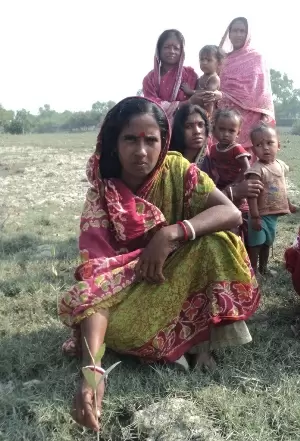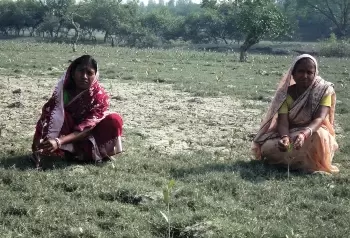Woken by a devastating cyclone, women are creating green embankments for survival

22-March-2013
Vol 4 | Issue 12
Groups of women across several remote villages in the Sundarbans Delta of South 24 Paraganas in West Bengal have added one more task to their long list of daily chores.
Besides cooking, sending their children off to school, taking care of the family and keeping their mud huts tidy, they now get together to plant mangrove trees in the area to create green embankments that would prove crucial not just to their survival but of their ecosystem as well.
 |
|
Women from across several remote villages in the Sundarbans Delta have added one more task to their long list of daily chores - they now plant mangrove saplings (Photos: Saadia AzimWFS)
|
The inhabitants of this rich but vulnerable delta region, who, till just a few years back, were cutting the mangroves and sundari trees to clear the land for agriculture and other livelihood, today realise that ‘Bishsho Ushnayon’, the Bengali term for global warming, will drastically change their way of life forever, as the slowly rising sea levels start engulfing the islands.
The devastating Cyclone Aila, which had struck the tidal country in 2009, served as a wake up call for the five million residents of the region. Often described as the worst calamity in living memory, the cyclone had left about 150 people dead while over 40,000 homes were swept away.
Three years on and it still seems like families have yet to resume their ‘normal’ life. With the influx of saline water having rendered the soil unfit for agriculture - the mainstay for over 85 per cent of the residents – the men have been forced to migrate to places like Kolkata and Mumbai to work as labourers on construction sites and in factories.
It’s the women left behind who have taken on the responsibility of saving their rapidly eroding coastline.
“It is time for us to do something. If we do not plant these trees, we will vanish,” remarks Sushmita Bera, who organises mangrove plantation drives in a few vulnerable villages.
What has given their effort a fillip is support from government and non-government agencies that are aggressively promoting the re-plantation drives through the enforcement of the Mahatma Gandhi Rural Employment Guarantee Act (MGNREGA).
Not only are the women getting paid for rearing mangrove saplings, they are also getting 100 days of assured employment as they plant them.
Explains Aarti, 30, of Aakash Ganga Self Help Group (SHG) which has been on a planting spree for the last six months, “We nurture the saplings and then sell them to NGOs like Save the Children and Sundarbans Social Development Centre. These saplings are then handed back to us to be planted on the banks to protect the coast from erosion.”
In villages like Gopalnagar and Durgagovindapur Gram Panchayat, it’s common to see women standing in knee-deep fresh water nurseries set up near their homes where they first rear the saplings away from the salty water of the seas that can wash them away during the high tide.
It takes around 45 days for the saplings to become strong enough to then be replanted in nearby rivers beds for another 15 to 20 days which is when they are gradually splashed with saline water so that they are able to survive on the coast.
The entire process takes around two to three months. Once the saplings seem to be growing fine and are strong they are transplanted on to the banks to build the green embankments. The mangrove takes about three to four years to grow into a tree.
Says Soumen Biswas of the Sundarbans Social Development Centre, a community development agency working since the last 25 years in the region, “The mangrove saplings are very fragile and many die before even they are introduced to saline water.
“It is a rigorous process and hence community involvement is very crucial. We have tried in to mobilise the women of the area so that they are able to run for the nurseries and care for the saplings as their own children.”
Under the plantation drive, the women are mobilsed by the local NGOs and they earn Rs 134 daily, the fixed rate under the MGNREGA for providing embankment work in the area.
Awareness and a better understanding of the environment have certainly changed attitudes around here.
Elaborates Prof. Ashish Ghosh, environmentalist and Director of the Centre for Environment and Development, “These are people who have never feared from venturing deep into the jungles for their survival and no one understands the value of preserving the forests more than they do.”
Of the over 52 inhabited islands, large portions of Lohachura and Ghoramara have been flooded and eroded. Though concrete embankments have been built around here, it has been observed that a forested area – which forms the green embankments – is able to contain disasters better.
As part of the Bonbibi SHG in Gosaba block, Malibika, 30, had been working with the plantation drive for the last two years. She says, “Concrete embankments are long gone and despite the government trying hard to build embankments across the delta coastline, it has been really difficult to maintain them. The easier way out is in planting varieties of mangrove that can sustain heavy saline content of water.”
 |
|
The women of Malti's SHG have covered almost 500 hectares of land since they started planting a year back
|
In the last six months, committed women brigades have planted more than five million mangrove saplings in the disaster prone areas. But Malti of Akash Ganga SHG, which has covered almost 500 hectares of land since they started planting a year back, admits, “With the low survival rate of these plants, a full-fledged green embankment it is still a distant dream.”
Prof. Sugata Hajra of the School of Oceanography, Jadavpur University, is one of the few who truly understands the value of the work these women have undertaken despite the odds of displacement and livelihood crisis.
She says, “If the Sundarbans vanish in the water, Kolkata, too, will also not survive. So this is a kind of struggle for survival. The gravity of the situation is not fully known probably because coastline erosion is a slow process and many a time people migrate much before the land disappears.
“Some of the areas of the Sundarbans are facing this problem. But even though the men folk have gone, the women have ably taken charge of families and the habitat.”
Judging by Malti’s observation, the task of creating an indestructible green embankment is a long and hard one. But she and her friends are determined to survive and flourish – just like the mangrove saplings that they are nurturing today. - Women's Feature Service














